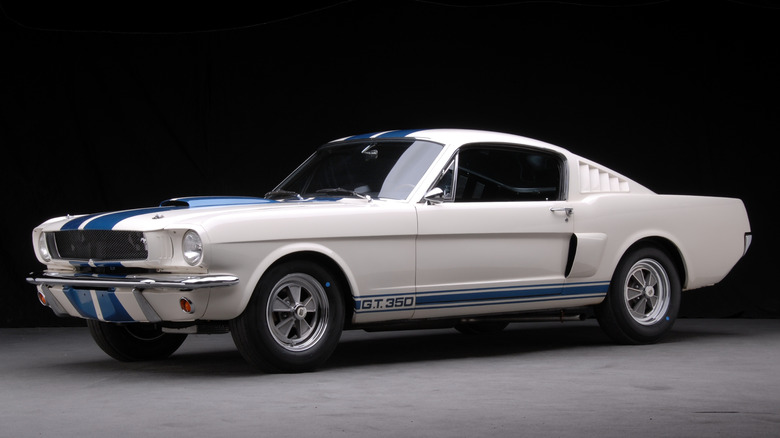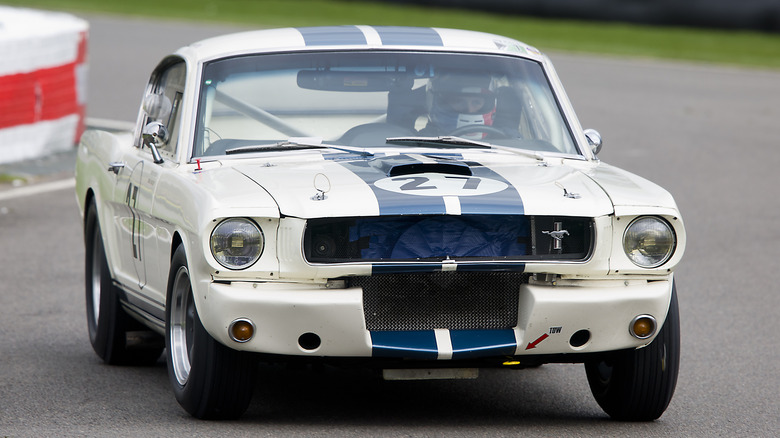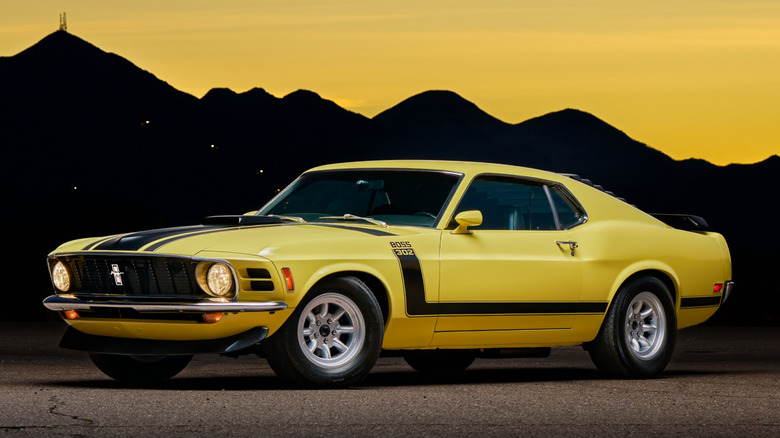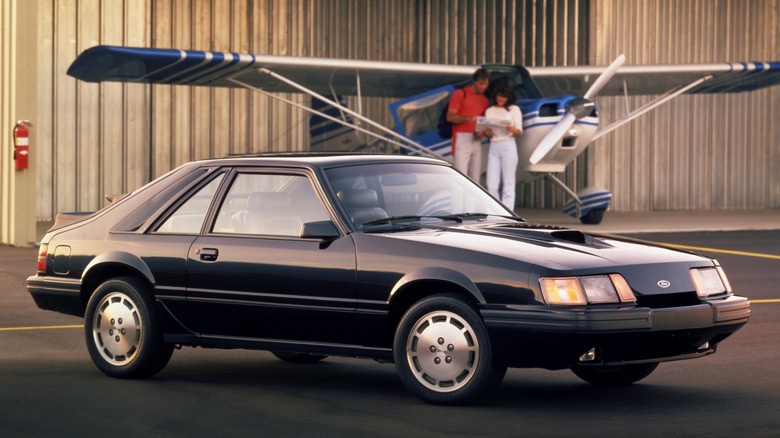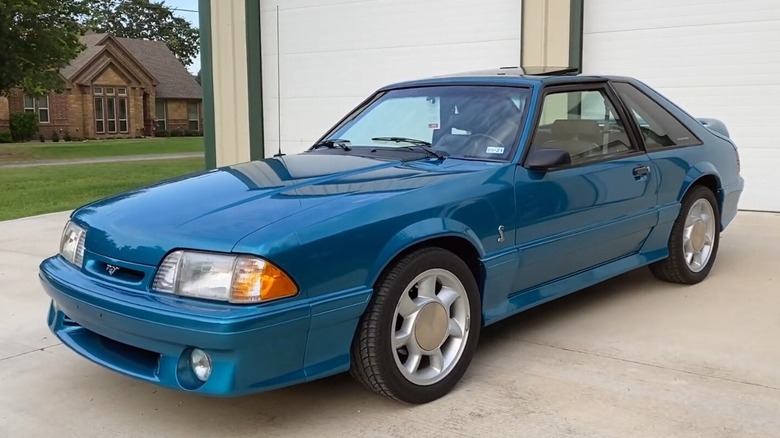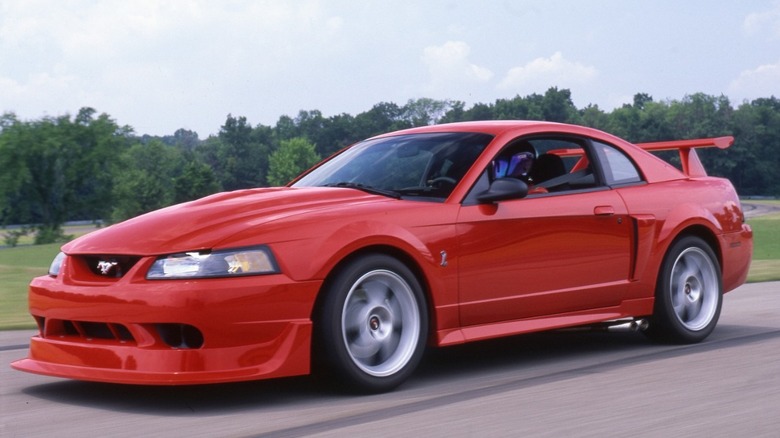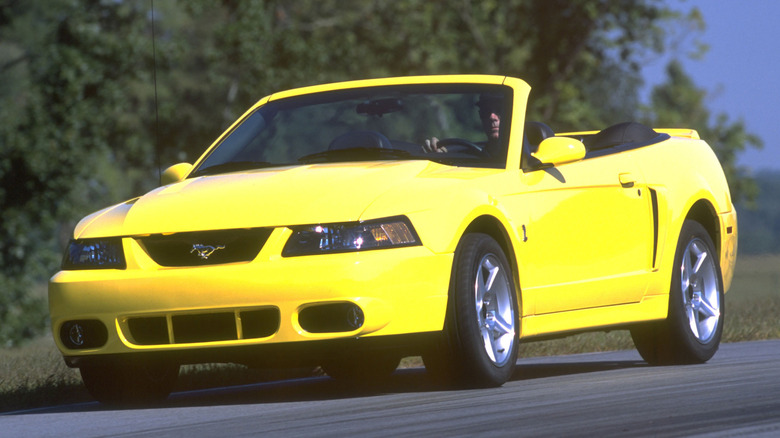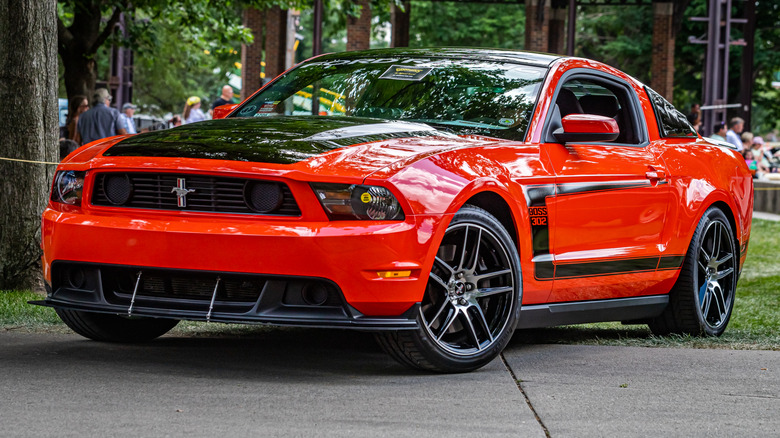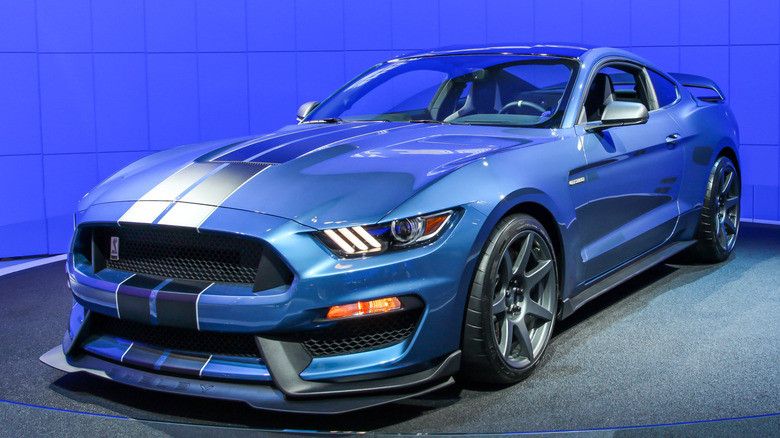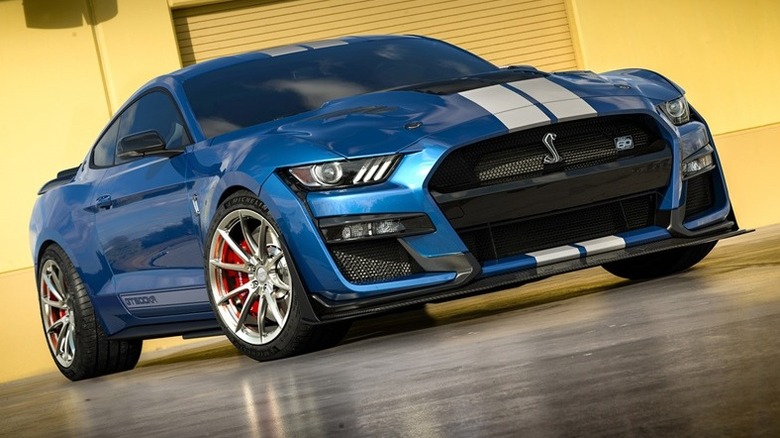9 Limited Edition Mustangs Every Ford Fan Should Know About
The Ford Mustang has been the pony car with staying power for sixty years. Since it burst upon the automotive scene in 1964 (as a 1965 model), it has been the original and longest continuously running vehicle of its type. Unlike its competition from GM, Chrysler/Daimler/FCA/Stellantis, and even AMC (American Motors Corp.) for a brief time, the Mustang has been the only pony car to have an unbroken production run. After the recent demise of the Camaro and the Challenger, the Mustang is the last V8-powered American pony car standing.
There can be many reasons to create a "limited edition" version of a car, ranging from genuine technical innovation to the marketing department's need for a sales-boosting trim package. With the Mustang's sixty-year model run, there are many to choose from.
For the purposes of this article, we will avoid trim packages that don't improve performance and the focus will be on actual vehicles that were made specifically as a limited edition. While we will include Shelby Mustangs, we will exclude products from other Mustang tuners. Here are nine limited edition Ford Mustangs that every Ford fan should know about because they created a new level of performance that went beyond what had been previously been available in the Mustang stable.
1965-66 Shelby GT350
The 1965-66 Shelby GT350 is the Mustang that Ford took racing. Ford wanted to compete and win against the Chevy Corvettes in SCCA's B/Production class. They brought in Carroll Shelby, who had worked his magic on the Ford-powered Cobra. Ford shipped Mustang fastbacks, initially white, to Shelby's California facility, equipped with the high-performance 289 V8 and four-speed transmission, but without back seats (so that they would meet SCCA sports car regs) and hoods (replaced by a fiberglass version with functional scoop).
Engine-related changes made by Shelby included an upgraded carburetor, hi-riser intake manifold, hotter cam, and free-flowing exhaust headers to boost the engine's output from 271 to 306 horsepower. Zero to 60 mph took 6.5 seconds, with a top speed of 126 mph.
The suspension was also massaged, with traction bars, droop-limiting cables, and a locking differential in the rear, combined with revised geometry, faster steering, and larger front sway bar in the front, plus super-firm Koni shocks and special Goodyear tires good for 130 mph all around. Interior additions included a tach, oil pressure gauge, Cobra-badged wood-rimmed steering wheel, and three-inch wide racing seatbelts. The result was a racecar for the road.
A total of 526 Shelby GT350s were made in 1965, including 36 R-type racing versions. In 1966, Hertz placed an order for 1,000 vehicles, which were named GT350H. This bumped up the 1966 GT350 production total to 2,378, including four rare convertible prototypes. Total production for both years was 2,904.
1969-70 Mustang Boss 302
The 1969-70 Mustang Boss 302 was Ford's limited-edition answer to a big problem. Ford's arch-rival Chevrolet was selling large quantities of the Camaro Z/28, the Mustang's competitor in SCCA's Trans Am racing series. The Z/28's sales success came from its winning streak on the racetrack. Ford needed a car that could win on track and sell in showrooms afterward, while making at least 1,000 for the streets, as SCCA rules required. The Boss 302 was that car.
The Boss 302's incredible engine was based on a strengthened Windsor small-block, but used better-breathing heads derived from the upcoming 351 Cleveland engine. Combined with a steel crank, four-bolt mains, solid lifters, 780 cfm Holley, and a 10.5:1 compression ratio, the Boss 302 put out a conservative 290 horsepower at a high-revving 5800 rpm. A four-speed Toploader transmission sent power to an open, limited-slip, or locking diff.
The Boss 302's chassis provided handling recognized as the best of any contemporary Ford. Its "Competition Suspension" offered stiffer springs, thicker spindles in front, heavy-duty dampers staggered on the rear axle, bracing on the shock towers, and bigger wheels and tires. Faster steering was standard, with power steering as an option. Braking was provided by 11.0-inch power front discs and drums on the rear (hey, it was 1969-70!).
Front and rear spoilers as well as unique striping bedecked the exterior, while the interior remained basic, optionable based on the buyer's wishes.
Production of the 1969-70 Mustang Boss 302 totaled 8,252, including 1,934 1969 models and 6,318 1970s. This makes the 1969 much rarer.
1984-86 Mustang SVO
The SVO was an attempt to create a great-handling, high-revving Mustang that could appeal to buyers considering a European high-performance car. The SVO, a car way ahead of its time, was the first car produced by Ford's Special Vehicle Operations, a group of engineers charged with improving Ford's image through racing victories and low-volume, high-performance street cars.
Under the hood, SVO placed an enhanced fuel-injected version of Ford's "Lima" 2.3-Liter four-cylinder turbocharged engine, with electronic knock-sensor technology plus hood scoop-fed intercooler with up to 14 psi of boost. Producing the same 175 horsepower as the Mustang GT's 5.0-Liter V8, the SVO was formidable. Power was increased to 205 hp halfway through 1985. The 5-speed transmission had a Hurst shifter.
Road-racing-inspired upgrades to the SVO's suspension included a faster steering ratio, forged lower control arms, thicker anti-roll bars front and rear, gas-filled adjustable Koni shocks, ventilated discs all around, and the widest tires ever installed on a Mustang to that point – 225/50VR-16s. The SVO is said to be one of the best-handling Mustangs ever built.
The SVO's interior received unique aggressively bolstered sport seats, pedals optimized for heel-and-toeing, full instrumentation, and suede trim. Exterior design touches featured a unique front fascia, offset SVO hood scoop, bi-wing rear spoiler, and SVO-only sail panels.
A total of 9,844 1984-86 Mustang SVOs were made during its three years of existence, including 40 bought by Hertz for its rental fleet.
1993 Mustang SVT Cobra
The 1993 Mustang SVT Cobra represented the final year of the 1979-93 Fox-body Mustang. This limited-edition Mustang was available in only three colors (Red, Teal, and Black) and is the high-water mark of the Fox-body V8 models.
SVT was Ford's Special Vehicles Team, an evolution of the previous SVO organization. Tasked with developing limited-edition, high-performance vehicles for enthusiasts, SVT revealed the SVT Cobra at the 1992 Chicago Auto Show.
The 1993 Mustang SVT Cobra was the top of the Mustang line, a step above the Mustang GT. With a V8 engine packing 235 horses (compared to the GT's 205), the Cobra engine received upgraded camshafts, "GT-40" cylinder heads, throttle body, and intake manifold. The drivetrain was a five-speed Borg Warner T-5 with upgraded clutch and 8.8" rear axle.
The SVT Cobra's suspension boasted linear-rate front springs, specifically valved Tokico shocks, four-wheel disc brakes, and a thinner front anti-roll bar (to soften the suspension and let the 245/45ZR-17 tires load up more gradually).
Inside, the SVT Cobra looks much like the GT, with the only difference being SVT floor mats. Outside, the Mustang SVT Cobra received unique seven-spoke directional wheels, a unique rear spoiler, and snake emblems on both front fenders.
A special Cobra R model, so valuable today, was produced for IMSA/SCCA racing series, featuring stiffer suspension, upgraded brakes, and the deletion of 150 lbs. of unnecessary creature comforts. There were 4,993 Mustang SVT Cobras made in 1993, along with 107 Cobra R models.
2000 Mustang SVT Cobra R
The 2000 Mustang SVT Cobra R was the third Cobra R, following the 1993 and the 1995 editions. When is it time for a new R? As John Coletti, R program manager, states: "First, when there's a need, and second, when the new one will be able to outshine the old one by far."
The 2000 Cobra R, with its great engine, certainly exceeded the 1995 model's abilities. It had 85 more horsepower (385 hp vs 300), a higher top speed (175 mph vs 151) and cost $20,000 more than its predecessor. Available only in bright red, the 2000 Cobra R sports a huge rear wing, a large front spoiler, and a splitter that can easily be added for racing or shows, then removed to protect it from hazards. Inside, racing Recaros hold you in place.
The 2000 Mustang SVT Cobra R's engine is a normally aspirated 5.4-Liter DOHC V8 originally found under the Lincoln Navigator's hood. SVT engineers made it fit into the Mustang and added forged steel connecting rods, modified pistons, aggressive camshafts, and cylinder heads with much better breathing. Short tube headers lead to side exhausts ahead of the rear wheels. The first six-speed transmission in a Mustang (Tremec T56 with B&M Ripper shifter) directs the power to a hydro-mechanical differential.
Underneath, Bilstein shocks, Eibach springs, and new-for-1999 independent rear suspension keep the power under control. Vented discs all around with racing pads handle stopping. Fat, specially made 265/40ZR-18 tires provide the road-to-car interface. A total of 300 of these incredible machines were made.
2003-04 Mustang SVT Terminator Cobra
The 2003-04 "Terminator" Cobra is the most powerful Mustang of its generation. With a supercharged 4.6-Liter DOHC engine putting out 390 horsepower, the Terminator Cobra was SVT's response to the V8's difficulty in getting enough intake air, which caused Cobra horsepower shortages and lawsuits over 1999 models. Starting fresh for 2003 based on the supercharged F-150-based SVT Lightning's approach, the result is a legendary limited-edition Mustang that took its SN95 platform out of production on a high point in 2004, two years after GM killed its pony cars.
The Terminator Cobra's engine used an iron block for durability under pressure, along with the Cobra's proven forged steel crankshaft. Dished pistons lowered the compression ratio to compensate for compressed supercharged air, while new aluminum alloy four-valve heads improved breathing. The Lightning's Eaton supercharger was used, with 8 psi maximum boost. A water-to-air intercooler reduces intake air temperature. Forged Manley connecting rods were sourced from the aftermarket to strengthen the drivetrain.
Many familiar Cobra elements are used, including Tremec T-56 six-speed, Bilstein shocks, and Recargo seats. New were a revised independent rear suspension, more linear steering, vented hood, and ducktail spoiler atop the trunk lid. Coupes and convertibles were available.
With a lower price ($20,000 less than the 2000 R!) and two years of production, the 2003-04 Terminator Cobra is somewhat easier to afford and acquire. Production totaled 19,140 (13,476 in 2003 and 5,664 in 2004).
2012-13 Mustang Boss 302
The 2012-13 Mustang Boss 302 was a callback to the iconic 1969-70 Mustang Boss 302 and its great engine. The Boss carried Ford's banner in the hotly contested Trans Am racing series, going up against pony cars from GM, Chrysler, and American Motors. The first generation of these groundbreaking vehicles captured baby boomers' hearts as they came of age. The original Boss 302 won Ford the manufacturer's championship in 1970, cementing its place in history. So Ford brought it back for two years as its top Mustang.
The heart of the 2012-13 Boss 302 was its 32V DOHC normally aspirated engine, known as "Roadrunner" (what else could outrun a Coyote?). Based on the Coyote V8, the Roadrunner got a 32-horsepower boost to 444 horsepower with a new intake manifold, stronger cylinder heads with larger intake valves, racing bearings, and higher-lift camshaft. A slick-shifting six-speed transmission with upgraded clutch directs power to a limited-slip diff.
The Boss' lowered suspension gets adjustable shocks, stiffer springs, and thicker rear sway bar, with 255/40ZR19 front tires and 285/35ZR19 rears. Brakes are upgraded with Brembo four-pots up front and high-performance pads all around.
An even more track-focused Laguna Seca Edition was named after the track where the original Boss 302 won the first 1970 Trans Am series race. The Laguna Seca came with unique wheels, racing tires, front brake ducts and splitter, deleted rear seat with cross brace, and Recaro seats. Total 2012-13 Boss 302 production (minus special-order race-prepped 302R and 302S versions) was 8,289, with 6,775 standard versions and 1,514 Laguna Secas made.
2015-20 Shelby Mustang GT350R
The 2015-20 Shelby Mustang GT350R is the track-focused limited-edition version of the Shelby Mustang GT350, which was made by Ford for six model years and discontinued as of 2021. Starting from the A-pillar and going forward, the GT350/GT350R is a completely different Mustang.
The changes that transformed the GT350/GT350R into a track star center around its 5.2-Liter, 526-horsepower, naturally aspirated, "Voodoo" flat-plane crank V8. Running at a 12.0:1 compression ratio, that translates to 100 horsepower per liter! Supporting this magnificent mill, Ford incorporated unique aluminum steering knuckles and brake calipers, stiffer front-wheel bearings, magnetorheological dampers (first time on a Ford), and wider front track for improved handling. A Tremec six-speed manual sends power to a Torsen limited-slip differential and 305/35ZR19 rear tires (295/35ZR19 in front).
Inside, the primary changes consisted of a pseudo-suede steering wheel cover, Shelby badging, and a pair of Recaro seats. Outside, the GT350/GT350R sports unique and more aggressive front bodywork, made necessary by its wider front track.
The R version added improved aero, firmer suspension, wider track tires, oil/transmission/differential coolers, and carbon fiber rear wing, reducing weight by installing carbon fiber wheels (also wider) and deleting the rear seat. This package helped the GT350R to achieve even higher performance levels under track conditions.
A total of 3,511 2015-20 GT350Rs were produced, compared to 20,063 GT350s. That equates to 12.5% of combined production, making the Rs very rare and desirable.
2020-22 Shelby Mustang GT500KR
Our final limited-edition Mustang, the 2020-22 Shelby Mustang GT500KR (King of the Road), has the most horsepower of all. A comprehensive performance upgrade that will be applied to the Shelby Mustang GT500 (which is no slouch with 760 horsepower), the GT500KR ups the ante and celebrates Shelby's 60th anniversary with its Whipple/Shelby-supercharged 900 horsepower!
Only the third Shelby GT500KR in history (previous versions were made in 1968 and 2008), the current car has a new 3.8-Liter supercharger on its 5.2-Liter engine. Combined with a high-volume intercooler and heat exchanger plus an open cold air intake, the GT500KR produces full power on 93 octane pump gas. Helping handle the power are a TREMEC 7-speed dual-clutch transmission, performance half-shafts, ride–height adjustable springs, Shelby-spec sway bars, MagneRide® shocks, and upgraded 20" wheels and tires.
The GT500KR's interior gets leather seat recovers, embroidered floor mats, and a numbered dash plate. Exterior upgrades include an ultra-light carbon fiber hood with functional air vents, front splitter, rear diffuser, and Gurney flap. Optional are Le Mans over-the-top stripes in vinyl or paint, a polished supercharger, and rear seat delete with harness bar.
The number of 2020-22 Shelby Mustang GT500KRs has been limited to 180 for the U.S. (60 per year) and 45 for international markets. All have been reserved. The first car produced was auctioned off on January 29, 2022, by Barrett-Jackson to benefit the Carroll Shelby Foundation and the Juvenile Diabetes Research Foundation. The auction raised $700,000 for the two charities.
